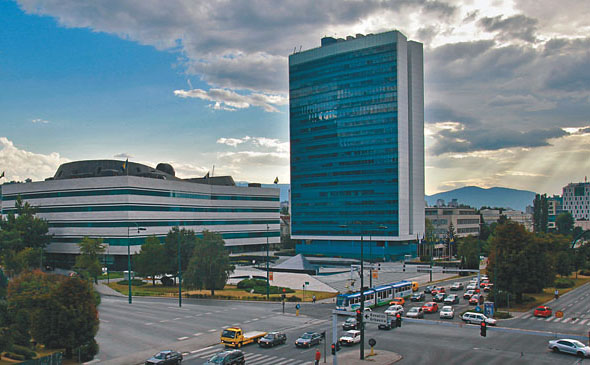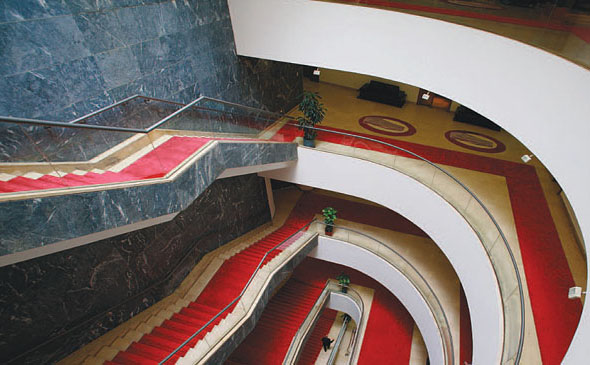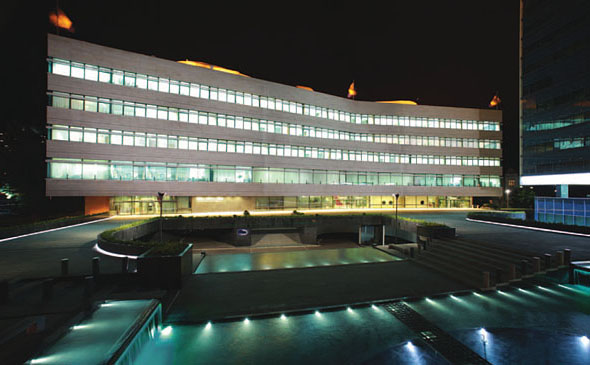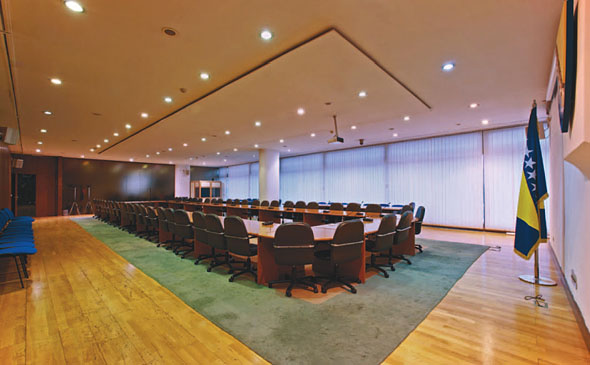Building of the BiH Parliamentary Assembly
Building of the BiH Parliamentary Assembly
The Building of the Parliamentary Assembly had to respond to very complex functional requirements and visual criteria. At the time it was finished, the building of the Assembly of SRBiH was the only building for that purpose in this part of Europe designed in a modern style.
After the liberation of Sarajevo in 1945, the National Anti-Fascist Council of Bosnia and Herzegovina (ZAVNOBiH), the predecessor of the National Assembly, was situated in the building of the National Bank on Tito Street. Due to the increased requirements of the National Assembly of Bosnia and Herzegovina, a building was constructed in 1952 in the Sarajevo neighborhood of Bistrik. However, soon afterwards its capacities proved to be inadequate to satisfy the needs of this institution on a long-term basis. Consequently, in 1954, a decision was made to begin with the preparations for the construction of a new assembly building in the locality of Marindvor, which was previously planned to be the future administrative-political centre of the town.

In the same year, a vacancy was announced for the submission of the future building architectural design for the National Assembly of the People’s Republic of Bosnia and Herzegovina, and the project proposed by the architect Juraja Neidhardt won. Based on this project, an investment plan was developed and granted in 1956.
Although the specific preparations for the construction of the Assembly building in Marindvor in Sarajevo commenced back in 1954, it was not built until 28 years later. There were two reasons for this delay in its construction. On the one hand, the delayed construction was undoubtedly affected by economic reasons, given that it was a very ambitious construction undertaking. On the other hand, as ideas emerged in the meantime, it was decided that another building should be built to accommodate all of the Republic’s administrative organs. Thus, in 1964, the development of investment-technical documentation began for the construction of a building to accommodate the Republic’s administrative organs next to the future building of the Assembly. According to the plans at that time, in terms of installations and technical matters the skyscraper for such a purpose was supposed to be connected to the Assembly building. It was also planned that the Common Service be established to provide administrative-technical services to the Assembly, Executive Council and the other administrative organs of the Republic.
However, despite all of the foregoing and primarily for financial reasons, the construction of the Assembly building of the Socialist Republic of Bosnia and Herzegovina was postponed until 1978. Meanwhile, the project supervisor of the SRBiH Assembly building fell ill and the construction of the building in Marindvor continued under the management of professor Hamdija Salihović.

When finished in 1982, the present building of the Parliamentary Assembly of Bosnia and Herzegovina became the seat of the Assembly of the Socialist Republic of Bosnia and Herzegovina. Given that it was an Assembly with a complex organizational structure, within which a large number of Councils and Committees operated, this building had to respond to very complex functional requirements and visual criteria. At the time it was finished, the building of the Assembly of SRBiH was the only building for that purpose in this part of Europe designed in a modern style.
It is noteworthy that the final design of the Assembly building slightly differed from the initial project which won the first prize in an anonymous competition in 1954. Today the building is higher by one floor, and the façade was subsequently changed. It is likely that the largest deviation from the project is the absence of the segment shape over the main hall which, in its shell shape, would have symbolized congregation. Nevertheless, the buildings of the Assembly and the Republic administrative authorities have still retained the most important elements of the initial idea and vision.
Specifically, the Assembly building was designed under the counterpoint principle, which, according to Neidhardt, was “the best quality-element of the architectural design.” The building design includes “a waist,” that is, “organically understood architecture” which, according to the architect himself, was contrary indeed to the shape-concept of the Executive Council skyscraper which, by its two-part form comprising two powerful obelisks, was supposed to, in a visual sense, symbolize Bosnia and Herzegovina with its two regions.

The central interior area of the building of the Parliamentary Assembly of Bosnia and Herzegovina is polyvalent, with multiple meanings through its spatial-artistic and ornamental characteristics. This space was considered to be one of the most beautiful of its kind in Bosnia and Herzegovina and in the region and, according to contemporaries, was one of the most demanding tasks and preoccupations of its architect, who was firmly disinclined towards monovalent architectural forms.
Even today, the building of the Parliamentary Assembly of Bosnia and Herzegovina is one of the most monumental and most representative buildings in the country. This building, which by its closeness and functional connections with the Building of Friendship between Greece and Bosnia and Herzegovina, wherein a large number of Bosnia and Herzegovina institutions have been placed, constitutes a uniform architectural structure and administrative entity situated in the center of Sarajevo.
A four-storey building, 107 meters long and having approximately 25,000 square meters of usable area, it today satisfies the requirements of the Parliamentary Assembly of Bosnia and Herzegovina and all of its bodies and services, including certain organizational parts of the Council of Ministers of Bosnia and Herzegovina and other institutions of Bosnia and Herzegovina. Apart from the Grand Hall with 52 seats and an additional 112 gallery seats for visitors and journalists and 17 seats for interpreters, the building also includes the White Hall with 180 seats for the sessions of the House of Representatives, and the Blue Hall with 126 seats for the sessions of the House of Peoples of the Parliamentary Assembly of Bosnia and Herzegovina.
During the war in Bosnia and Herzegovina (1992–1995), the building suffered considerable damage. A long-lasting and comprehensive reconstruction lasted for 11 years and was completed at the beginning of 2009, when its façade was restored. By the renovation of the square in front of the building in May 2010, the reconstruction of this administrative complex was completed in its entirety. During the war in Bosnia and Herzegovina (1992–1995), the building of the Parliamentary Assembly of Bosnia and Herzegovina was practically on the frontline, due to which circumstance its façade and interior were severely damaged. This was obviously one of the reasons for not holding the first post-war convocation of the Parliamentary Assembly of Bosnia and Herzegovina in the Assembly building. The initial work on the renovation of the damaged building commenced in autumn 1996 with reconstruction of the dome. The initial renovation work on the building of the Parliamentary Assembly of Bosnia and Herzegovina was funded by the European Commission and was restricted to protection from precipitation and moisture and to making at least a part of the damaged building function in any way possible, due to the ever increasing needs of the institutions of Bosnia and Herzegovina.

It was only with the second convocation of the Parliamentary Assembly of Bosnia and Herzegovina that the Assembly building began to be used again. On November 26, 1998 it hosted the first session of one of the Houses of the Parliamentary Assembly of Bosnia and Herzegovina, more specifically, the constituent session of the second convocation of the Parliamentary Assembly of Bosnia and Herzegovina. It is interesting that the technical parliamentary services of this institution at that time employed no more than about 10 people. They were placed into two offices which served not only their needs, but the needs of the chairmen of the Houses of the Parliamentary Assembly of Bosnia and Herzegovina as well. The remaining part of the building, that is, its functional part, was used by other institutions of Bosnia and Herzegovina.
In March 2004, the reconstruction of the White Hall was completed. Thus, after 12 years, the conditions were created for the sessions of the Houses to be held again on the premises intended and designed for these purposes. Up until March 22, 2004, when the first joint session of both Houses of the Parliamentary Assembly was held in the renovated hall, the sessions of its Houses had been held in a lounge on the first floor which served to hold protocols and ceremonies before the war.
The reconstruction of the White Hall was also symbolic, since the sessions held in it were a step forward towards the establishment and strengthening of this legislative institution of Bosnia and Herzegovina. The renovation costs were borne by the European Union pursuant to the “Reconstruction 2000 – Europe to Sarajevo” Funding Agreement.
One and a half years later, on September 30, 2005, with the assistance of the Government of the friendly country of the Kingdom of Norway, the Grand Hall in the building of the Parliamentary Assembly was finally reconstructed. The Hall in which the Assembly of the SRBiH held sessions before the war was terribly damaged. The decision of the Kingdom of Norway to support the institutional reconstruction of Bosnia and Herzegovina was considerably influenced by the efforts and willingness of the President of the Parliament of the Kingdom of Norway at that time, Jorgen Kosmo, and the considerable assistance of the Norwegian Ambassador to our country at that time, Henrik Ofstad. Owing to them a range of earlier donations by the Norway Government were received by which the archive premises and offices were arranged, and an internet connection installed in the building of the Parliamentary Assembly of Bosnia and Herzegovina.
The last reconstructed hall of the Parliamentary Assembly of Bosnia and Herzegovina, the Blue Hall, went back into use in September 2008. Its reconstruction was entirely funded from the budget of the Parliamentary Assembly of Bosnia and Herzegovina.
However, due to objective circumstances and a shortage of required funds, it was long before the exterior of the Parliamentary Assembly of Bosnia and Herzegovina was reconstructed. This would come only on May 29, 2008, when Bosnia and Herzegovina and the Kingdom of Norway entered into an Agreement on funding the reconstruction and renovation of the building façade. By this act the Kingdom of Norway once again strongly supported post-war reconstruction and the strengthening of the Parliamentary Assembly of Bosnia and Herzegovina. This long-term and comprehensive renovation lasted 11 years and ended in early 2009 with the renovation of the façade. During the reconstruction, certain changes were made to the façade so as to modernize and improve the look of the building.
Considering that both buildings of the administrative complex in the centre of Sarajevo, including the building of the Parliamentary Assembly of Bosnia and Herzegovina, were reconstructed in the meantime, it was only when the work on the reconstruction of the Square of Bosnia and Herzegovina was finished in May 2010 that this architectural achievement finally regain its compactness and visual impressiveness. The reconstruction of the square was funded from the budget of the Institutions of Bosnia and Herzegovina and included only those works which were required for the square to regain its pre-war look, the way it was designed by the architect Dušan Džamonja. Thus, with its own funds, Bosnia and Herzegovina reconstructed the square which carries its name, and the Parliamentary Assembly of Bosnia and Herzegovina acquired a setting worthy of the role this institution should play in the society of Bosnia and Herzegovina.
– Group of authors

